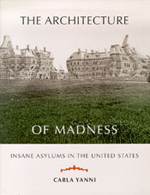Known colloquially as Booby hatches, nut houses, or looney bins, psychiatric hospitals have been familiar features of the American landscape since the 19th century.
Located mostly on the outskirts of town or in the countryside, these insane or lunatic asylums, ranging from classical temples to Gothic castles, epitomized a widely held belief among doctors and social reformers that mental illness was curable and that the elaborately conceived, grandly constructed buildings themselves were an effective means of treatment.
Carla Yanni, associate professor of art history, visited 25 former asylums throughout the United States in researching The Architecture of Madness: Insane Asylums in the United States (University of Minnesota Press, 2007). She found only a handful still operating as psychiatric hospitals. Some have been set to other uses, but most stand vacant.

Her book traces the evolution of American asylums from their beginnings in the late 1700s through the construction frenzy after the Civil War to their decline by the end of the century. "I’m interested not so much in architecture as the history of great monuments or of great men, but in how architecture reflects society’s values," said Yanni, an architectural historian who has taught at Rutgers for 10 years and has recently been named assistant vice president for undergraduate academic affairs.
“Environmental determinism was one of the key intellectual topics I wanted to explore,” Yanni said. “How does architecture shape behavior?” According to Yanni, the case of lunatic asylums is an extreme example of environmental determinism in which doctors believed that a changed environment would actually cure a disease.
"Picture a relatively small urban row house or a farm house. By comparison, the lunatic asylums I illustrate in my book were very large, orderly structures and very hierarchical in their arrangement," Yanni said.
In 19th century, there was a belief that by changing the environment one could change behavior, Yanni said. Thus, the mentally ill patient was taken from the supposedly disorderly city to the very orderly asylum, which was carefully sited with beautiful views, often set on the crest of a hill. The "cottage plan," often was used to describe the arrangement of psychiatric buildings, usually a village-like cluster of small structures instead of one monolithic building that contained all of the functions of the institution.
For much of the century, doctors believed that mental illness was curable if detected early and treated in specially designed buildings. Medical professionals frequently argued that mental illness could not be treated at home, Yanni said.
Today doctors prefer community-based care or some kinds of homelike environment. Yanni said she concurs with historians of psychiatry who believe that most of the people in the older hospitals were severely mentally ill.
"It is very difficult to tell if the idea worked," according to Yanni. They quickly became overcrowded. Money to construct the buildings was available, but there was never enough state support to run them.
"Very few of the hospitals lived up to the founders’ dreams," she concluded.
As an undergraduate at Wesleyan University in Connecticut, she wrote a few papers on the relationship between architecture and science and an honors thesis about the Buffalo State Hospital for the Insane. Her first book, Nature’s Museums: Victorian Science and the Architecture of Display, dealt with the architecture of natural history museums in Victorian Britain.